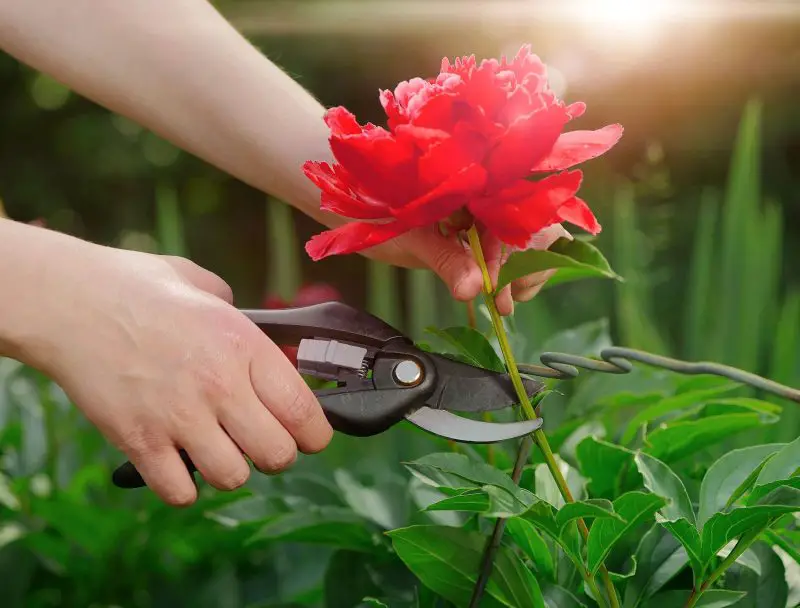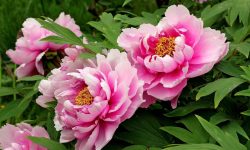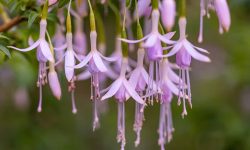Peonies stand among the most beloved perennials in any garden, admired for their lush petals, rich fragrance, and timeless charm. Their full blooms capture attention every spring, transforming simple landscapes into vivid displays of color and life. Yet, behind those breathtaking blossoms lies a rhythm of growth that depends on careful seasonal care. One of the most important yet often misunderstood steps is pruning. Knowing when to prune peonies and how to do it correctly ensures stronger plants, longer lives, and abundant flowering year after year.
Pruning peonies is not about cutting randomly; it’s about understanding their natural cycle and guiding that rhythm. The right timing strengthens the roots, prevents disease, and keeps the plant’s energy focused on producing future blooms. Many gardeners either prune too soon or too late, unknowingly limiting the plant’s potential. With proper pruning, however, you help peonies store nutrients, grow sturdier stems, and prepare for next season’s flowers. This guide explains the best time to prune, the proper techniques for each type, and how this single habit can transform your peonies into lasting symbols of beauty and renewal.
Understanding the Peony Growth Cycle

To prune peonies successfully, you must first understand their growth rhythm. Peonies move through distinct stages each year, and every phase affects how they respond to pruning. In early spring, buds begin to emerge from the soil, often red or pink in color. These shoots grow quickly and transform into leafy stems that support flower buds. During this stage, the plant directs most of its energy upward to develop strong stems and large blooms. Any cutting or pruning during this period can interrupt growth and weaken the coming flowers.
After blooming, peonies enter a recovery phase. The flowers fade, but the green leaves stay alive and continue working. Through photosynthesis, the leaves collect sunlight and convert it into energy stored in the roots. This energy will feed next year’s buds. Many gardeners mistakenly cut back the foliage too soon, not realizing it’s still nourishing the plant. Allowing the leaves to remain until late fall helps the roots gather enough strength for another round of vibrant blooms. Timing becomes critical because premature pruning can reduce the plant’s energy supply.
As temperatures cool, the leaves begin to yellow and wilt. This signals the start of dormancy, the period when the plant rests and repairs itself underground. The roots remain active but hidden from sight, storing nutrients for the next spring. Late fall is when pruning becomes safe and beneficial. At this stage, trimming old stems and dead leaves prevents disease and prepares the plant for winter. Understanding this natural cycle helps you choose the perfect pruning time and ensures long-lasting, healthy peonies.
The Best Time to Prune Peonies
Timing is the most important factor when pruning peonies. The ideal period depends on the plant’s type and seasonal behavior. For herbaceous peonies, pruning should take place in late fall after the foliage has completely died back. This usually occurs once frost turns the leaves brown and brittle. Cutting the stems too early interrupts the flow of nutrients back to the roots. Waiting until the foliage naturally collapses allows the plant to store enough energy to bloom stronger in the next growing season. Patience ensures better recovery and healthier growth.
Tree peonies follow a slightly different schedule. Unlike their herbaceous relatives, tree peonies have woody stems that remain above ground all year. Pruning should occur in early spring before new buds begin to swell. This timing allows you to remove dead or weak wood without disturbing new growth. It also encourages strong branching and larger blossoms. Avoid pruning tree peonies in fall because new buds form during late summer, and cutting them too soon removes the next season’s flowers. Understanding this difference between types prevents accidental loss of blooms.
For intersectional, or Itoh, peonies, timing combines traits from both types. Prune them in late fall like herbaceous peonies, but leave a few inches of the woody base intact. This hybrid form regrows from that base each spring. Always use clean, sharp tools and cut close to the ground without harming the crown. No matter the variety, pruning at the right moment strengthens the plant’s core, prevents rot, and ensures an explosion of blooms once warm weather returns.
How to Properly Prune Peonies Step-by-Step
Pruning peonies requires care, timing, and precision. Begin when the plant naturally enters dormancy, usually in late fall after the first hard frost. At this time, the leaves have turned brown and dry, meaning they’ve already returned nutrients to the roots. Put on gloves and prepare sharp pruning shears disinfected with alcohol. Start by cutting each stem down to one inch above the soil. Make clean, firm cuts and avoid tearing the stems. Remove all dead leaves and surrounding debris. This cleanup step keeps the area open, discourages disease, and protects the roots from winter moisture buildup.
Once the old growth is removed, inspect the crown carefully. Look for thin, weak, or crowded stems that may block air circulation next season. Cut them away to give the plant more space to breathe and grow evenly. Always angle your cuts slightly downward to prevent water from pooling on the crown. For tree peonies, only remove the top few inches of dead wood or damaged branches. Their woody stems help protect buds forming for next year’s growth, so avoid cutting too deeply. Focus on creating a balanced shape that promotes airflow and sunlight penetration.
After pruning, collect and dispose of all trimmings away from the garden. Do not compost the material since it can harbor fungal spores harmful to future growth. Spread a thin layer of mulch around the crown to shield roots from freezing temperatures. Leave an inch of space between mulch and stems to prevent rot. Consistent pruning each year strengthens the plant, encourages healthy regrowth, and ensures brilliant, abundant flowers every spring.
Tools and Materials Needed for Peony Pruning
Having the right tools and materials makes pruning peonies easier, safer, and far more effective. Start with a sharp pair of garden shears or pruning scissors. Dull blades tear stems and leave uneven cuts that invite disease. Choose stainless steel blades for cleaner slices and easy maintenance. Keep rubbing alcohol or a mild bleach solution nearby to disinfect tools before and after use. This habit prevents the spread of fungus and bacteria from one plant to another. Garden gloves are equally important because they protect your hands from thorns, rough stems, and soil moisture. Wearing long sleeves and sturdy shoes helps keep you safe while working in cooler weather.
A clean bucket or garden bag is useful for collecting trimmed material. Remove all pruned stems, leaves, and debris immediately after cutting. Peony waste can carry spores of botrytis and other fungal diseases, so never leave it on the soil surface. A rake helps clear fallen material from the plant’s base, giving the crown more airflow. A soft garden brush or cloth can gently clean around the roots without disturbing the soil structure. For larger gardens, a wheelbarrow saves time when hauling cut material away for disposal. Keeping your work area tidy ensures faster cleanup and reduces contamination risks.
Mulch and compost are valuable materials to finish the job. After pruning, apply a thin layer of organic mulch like straw, shredded bark, or composted leaves around the crown. This protects the soil from frost and maintains steady moisture. Avoid piling mulch against the stems to prevent rot. A watering can or hose with a soft spray attachment helps rehydrate the soil gently. Proper tools and organized preparation make pruning smooth, efficient, and beneficial for long-term plant health.
Different Pruning Techniques for Peony Varieties
Pruning techniques vary depending on the type of peony you grow. Herbaceous peonies, the most common variety, die back completely each winter. Their stems and leaves fade after the first frost, signaling it’s time to cut them down. Trim all stems to about one inch above the soil, taking care not to injure the crown. Removing the dead growth prevents rot and fungal buildup during the cold months. Once pruning is done, clean the area thoroughly to eliminate leftover debris. Healthy soil and open airflow help the plant rest and prepare for strong new shoots in spring.
Tree peonies, in contrast, need a gentler approach. They have woody stems that remain throughout the year and form buds on the previous season’s growth. These buds produce the next round of flowers. Therefore, pruning should take place in early spring before buds swell. Inspect the branches closely and remove only those that are damaged, diseased, or crossing each other. Trim back weak stems to promote better air circulation and light exposure. Avoid heavy pruning, as cutting too much reduces flowering. Tree peonies grow slowly, so shaping them carefully helps preserve their natural beauty and structure.
Intersectional or Itoh peonies combine traits from both types. They have woody bases like tree peonies but die back partially each year. Cut the dead stems to just above the woody crown in late fall. This technique allows new shoots to grow from that base in spring. Avoid cutting too close to the soil, as the lower crown stores energy for next year’s growth. Consistent pruning improves shape, prevents disease, and keeps all peony varieties blooming vigorously season after season.
Common Mistakes to Avoid When Pruning Peonies
Pruning Too Early or Too Late
Timing mistakes are among the most common errors gardeners make when pruning peonies. Cutting too early, especially before the first frost, disrupts the plant’s energy flow. During late summer and early fall, the leaves still perform photosynthesis, sending vital nutrients to the roots. Early pruning stops this process and weakens the plant’s strength for the next season. On the other hand, pruning too late, after frost damage has set in deeply, allows fungi and bacteria to spread through decaying tissue. Waiting until the leaves naturally die back and turn crisp ensures the plant has stored enough energy for healthy regrowth.
Proper timing is about observing your plant, not just following the calendar. When leaves turn completely brown and stems begin to collapse, the plant is ready for pruning. Late fall usually provides the right conditions. This timing protects the crown from damage while preparing the plant for dormancy. By aligning pruning with the plant’s natural rhythm, you give peonies the best chance to recover and produce vibrant blooms in the coming spring. Correct timing always results in healthier roots, sturdier stems, and more consistent flowering every year.
Cutting Too Deep or Damaging the Crown
The crown of a peony is its growth center, where new buds form each season. Many gardeners make the mistake of cutting too deep and damaging this sensitive part. When the crown gets injured, the plant struggles to grow new shoots or may not bloom at all. During pruning, always leave about one inch of stem above the soil to protect this area. Clean, precise cuts help the crown remain healthy and intact. Avoid tearing or twisting stems, as this creates open wounds that invite rot and pests.
After pruning, inspect the crown carefully for any signs of mold or soft spots. If you notice decay, remove the affected material gently and allow the area to dry before mulching. Keeping the crown slightly elevated above soil level improves drainage and prevents water from pooling around it. Healthy crowns are the foundation for reliable peony growth. By handling this part with care, you ensure the plant regenerates naturally each spring. Protecting the crown means protecting the heart of your peony’s life cycle.
Using Dirty or Dull Tools
Using dirty or dull tools is one of the biggest mistakes when pruning peonies. Dirty blades carry bacteria, fungi, and spores that can infect freshly cut stems. Once infection begins, rot spreads quickly through the crown and root system, weakening the entire plant. Always clean pruning shears with alcohol or a mild bleach solution before and after use. Sharp, disinfected blades make smooth cuts that heal quickly. Dull tools crush plant tissue, leaving uneven wounds that attract pests and disease. Clean tools not only protect your peonies but also make pruning faster and safer.
Good maintenance habits prevent future problems. After each pruning session, wipe down your tools, dry them thoroughly, and store them in a dry place. Sharpen blades regularly using a file or whetstone to maintain clean precision. Never switch between diseased and healthy plants without disinfecting first. Keeping your equipment sanitized and sharp helps your peonies stay healthy and disease-free. Consistent tool care ensures smoother pruning, stronger stems, and better regrowth every season, making it a simple but vital part of long-term plant care.
Leaving Debris Around the Plant
Leaving debris around peonies after pruning creates ideal conditions for disease and pest development. Dead leaves, broken stems, and plant waste often contain fungal spores such as botrytis or powdery mildew. These pathogens survive winter and reappear in spring, infecting new shoots and flower buds. Decaying matter also attracts slugs, aphids, and other insects that damage tender stems. When moisture lingers under the debris, it keeps the soil damp for too long, encouraging root rot and bacterial growth. Cleaning up immediately after pruning prevents these problems and keeps your garden soil healthy and balanced.
Proper disposal makes a major difference. Always gather all debris and remove it from the garden rather than adding it to compost, where disease can spread easily. Use a rake or hand tool to loosen hidden waste near the crown, ensuring that the base remains open and well-aerated. Once the soil is clear, apply a thin layer of fresh mulch to retain moisture and regulate temperature. Keep mulch at least one inch away from the crown to avoid trapping humidity. Clean surroundings protect peonies through winter, help them overwinter safely, and guarantee vibrant, disease-free blooms each spring.
Caring for Peonies After Pruning
Proper care after pruning helps peonies recover quickly and prepare for the next growing season. Once all dead stems and leaves are removed, inspect the soil around the plant. Loosen compacted areas with your hands or a small garden fork to improve airflow and drainage. Healthy roots need oxygen, and soft soil helps water spread evenly. Water the plant thoroughly but avoid soaking it. The goal is to keep the soil slightly moist as the roots settle for winter. This balance prevents dehydration while reducing the risk of rot. A clean, hydrated bed supports root renewal during the plant’s dormancy phase.
Mulching plays an important role in post-pruning care. Apply a thin layer of organic mulch—such as straw, pine needles, or shredded bark—around the crown. This layer keeps the soil temperature stable, protects the roots from frost, and limits weed growth. Always leave about an inch of space between the mulch and the crown to prevent moisture buildup. In colder regions, increase the layer to three or four inches for added insulation. Remove the extra mulch gradually in early spring once the weather warms. Proper winter protection ensures your peonies survive harsh conditions and return stronger each year.
In the months following pruning, limit fertilizer use until new growth appears in spring. Peonies prefer a period of rest to rebuild energy naturally through their roots. Keep the area weed-free to reduce competition for nutrients. If your region experiences heavy rainfall, make sure excess water drains properly to avoid crown rot. Consistent maintenance keeps peonies vigorous, disease-free, and ready to produce lush, colorful blooms once the new growing season begins. This simple care routine ensures a healthy foundation for many years of beauty.
Signs of Healthy Peonies After Pruning
Recognizing the signs of healthy peonies after pruning helps you understand whether your plants are thriving. The first indicator appears in late winter or early spring when new shoots begin emerging from the soil. These shoots should look firm, upright, and reddish in color. Their appearance shows that the roots have survived the winter and are ready to push out new growth. As temperatures warm, these shoots turn green and produce dense, glossy leaves. Consistent color, sturdy stems, and even spacing all signal a well-recovered plant. If shoots rise evenly around the crown, your peony has successfully regained its balance and energy.
Another sign of good health is vigorous leaf and stem development during early spring. Healthy peonies grow strong foliage before flowering, using it to store nutrients for the coming months. The leaves should appear deep green without yellow spots or curling edges. A healthy plant also develops thick stems capable of holding large blooms without bending. Watch for fast, symmetrical growth on all sides of the plant. Consistent leaf formation proves that the root system is strong and free from fungal damage. Proper post-pruning care ensures this steady development and prevents deformities in later blooms.
When buds begin to form, their shape and texture reveal your success. Healthy buds feel firm and round, covered in a thin, smooth skin. They should grow steadily without dark spots or dryness. Once blooming begins, the flowers open fully, showing rich color and layered petals. The stems remain upright, and the leaves stay vibrant throughout the flowering period. These combined signs—steady shoot growth, rich foliage, and full blossoms—prove your peonies have recovered perfectly and will continue to thrive year after year.
Long-Term Maintenance for Lasting Blooms
Long-term maintenance ensures your peonies continue producing abundant, healthy blooms for decades. After each flowering season, remove faded blossoms to prevent seed formation. This simple step directs the plant’s energy back into the roots instead of wasted seed growth. Keep the soil around the base loose and free from weeds to allow better airflow and moisture balance. Weeds compete for nutrients and can harbor harmful pests. Every few years, top-dress the area with compost or aged manure to restore nutrients naturally. Consistent feeding and clean surroundings build a strong foundation for the next bloom cycle.
Water management remains crucial throughout the growing season. Peonies prefer deep, infrequent watering that encourages their roots to grow downward. Shallow watering keeps roots near the surface, making the plant more vulnerable to drought. Always check the top two inches of soil before watering. If it feels dry, water slowly until the ground feels evenly moist. Avoid overhead watering, which wets the foliage and promotes fungus. Instead, water directly at the base early in the morning. Proper hydration supports bud formation, improves stem strength, and keeps flowers vibrant during their blooming period.
Fertilizing and dividing older plants also extend their life and beauty. Apply a balanced fertilizer in early spring when shoots emerge and again after blooming ends. Avoid overfeeding, as too much nitrogen leads to lush leaves but fewer flowers. Every eight to ten years, divide overcrowded clumps to give roots more space to grow. Replant divisions in fresh, fertile soil at the correct depth. This process rejuvenates the plant, encouraging stronger stems and larger flowers. With proper maintenance, peonies remain resilient, rewarding you with dazzling blooms and timeless beauty season after season.
Final Thoughts on Pruning Peonies
Pruning peonies is more than a seasonal chore—it is a vital practice that shapes the plant’s long-term health and beauty. When done correctly, pruning allows peonies to breathe, grow stronger roots, and produce richer, more vibrant blooms each year. The key lies in timing and technique. Waiting until the plant enters dormancy in late fall gives the roots time to store enough energy. Clean cuts and careful handling prevent infections and ensure healthy regrowth in spring. With patience and consistency, every gardener can maintain thriving peonies that bloom reliably for decades.
Peonies reward attention with beauty that lasts. After each pruning cycle, the plant begins a quiet phase of renewal underground. During this time, roots grow deeper, stems prepare for the next season, and the crown strengthens. By removing dead foliage, you eliminate the hiding places for pests and diseases that could damage the plant in spring. This annual reset ensures the peony remains vigorous and capable of producing full, colorful blooms. With proper care, peonies can live for generations, often becoming treasured heirlooms passed down through families.
Each year brings new lessons in observing and understanding your plants. Weather patterns, soil health, and garden conditions can all influence when and how you prune. Staying attentive to these changes helps you adapt and keep your plants in peak condition. Over time, the results speak for themselves—strong stems, abundant flowers, and healthy, enduring growth. Pruning done with intention and care transforms peonies into lasting symbols of grace, strength, and renewal, filling your garden with color and elegance for years to come.
FAQs About Pruning Peonies
When is the best time to prune peonies?
The best time to prune peonies is in late fall after frost kills the foliage. At this stage, nutrients have returned to the roots, and cutting the stems helps prevent disease. Waiting until the leaves are fully brown ensures the plant is dormant and ready for pruning.
Should I cut peonies back after blooming?
Yes, but only remove faded flowers immediately after blooming to redirect energy to the roots. Do not cut the entire plant until fall. Removing seed heads early helps the plant store nutrients for next year’s blooms and prevents unnecessary stress during its growing phase.
Can pruning peonies too early harm the plant?
Yes, pruning too early removes leaves that still provide energy through photosynthesis. This weakens the roots and reduces flowering next year. Always wait until the foliage naturally turns brown and dies back before pruning. Correct timing ensures healthier, stronger plants each growing season.
How far should I cut peonies back when pruning?
Cut stems down to about one inch above the soil level. Leaving this short section protects the crown from rot and frost damage. Avoid cutting too deep, as it can harm the buds that form next year’s shoots and flowers. Always use clean, sharp tools for best results.
Do peonies need pruning every year?
Yes, pruning peonies annually keeps them healthy and disease-free. Removing dead stems and leaves improves air circulation, reduces fungal risk, and encourages stronger root growth. Regular yearly pruning also rejuvenates the plant, ensuring consistent blooms and vibrant foliage for many seasons to come.
Conclusion
Pruning peonies at the right time transforms an ordinary plant into a breathtaking garden centerpiece. With each careful cut, you encourage stronger roots, fuller blooms, and years of unmatched beauty. Peonies reward attention and patience, returning every spring with renewed color and fragrance. When you follow proper pruning practices, you not only protect their health but also preserve their timeless elegance for decades. Each bloom becomes a reflection of your care and dedication. With knowledge, precision, and love, your peonies will flourish, turning your garden into a lasting celebration of grace, strength, and natural perfection.






